Given the limitations in some evidence, the Mission was not able to determine “with absolute certainty” the use of a chemical weapon, but was able to determine the presence of sarin on samples that came from the alleged site of the incident.
UN News – In relation to the claims of a Syrian aerial chemical bomb at Al-Lataminah
Date of Report: September 16, 2019
Introduction
Eliot Higgins of Bellingcat claimed that a Syrian chemical aerial bomb, namely the M4000, was used to deploy sarin at both Khan Sheikhoun on April 4, 2017, and Al-Lataminah on March 30, 2017.
In a previous report, I debunked his claim the M4000 was used in Khan Sheikhoun. In part one of this two-part investigation, I looked at the claim made by Eliot Higgins that an M4000 was used in Lataminah.
In this concluding part, I will focus on the alleged recovered bomb remnants at Al-Lataminah and look to see if they are indeed unique pieces of an M4000. I will address the Eliot Higgins commissioned Forensic Architecture modelling of the M4000 and take a closer look into their methodology.
Methodology
Whilst carrying out this investigation I entered into communications with Forensic Architecture (will be referred to as FA going forward) to gain a better understanding surrounding the circumstances of their M4000 modelling, the reason for selecting some fragments over others, and their methodology used in measuring certain fragments.
I also narrate a video presentation of my attempts to point out oddities I uncovered with a filler cap presented as being part of the M4000.
Narrative – Recap
Eliot Higgins claims to have “established” that an M4000 was used in Khan Sheikhoun and Al-Lataminah. As mentioned above, I showed how he was wrong about that claim in Khan Sheikhoun in a previous report.
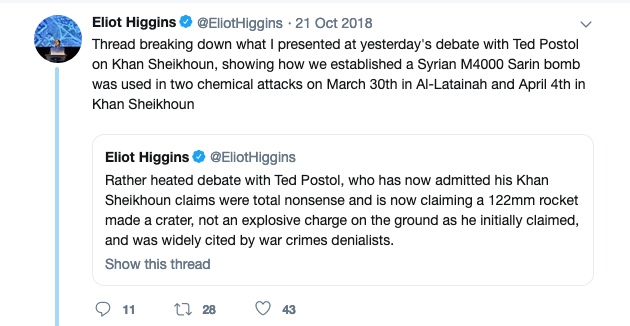
His determination centres around a “filler cap” that he claims, ‘links the two events’. I have marked the filler cap as “1” in the image below. The other two pieces of metal are simply ignored by Eliot, which will be discussed later.
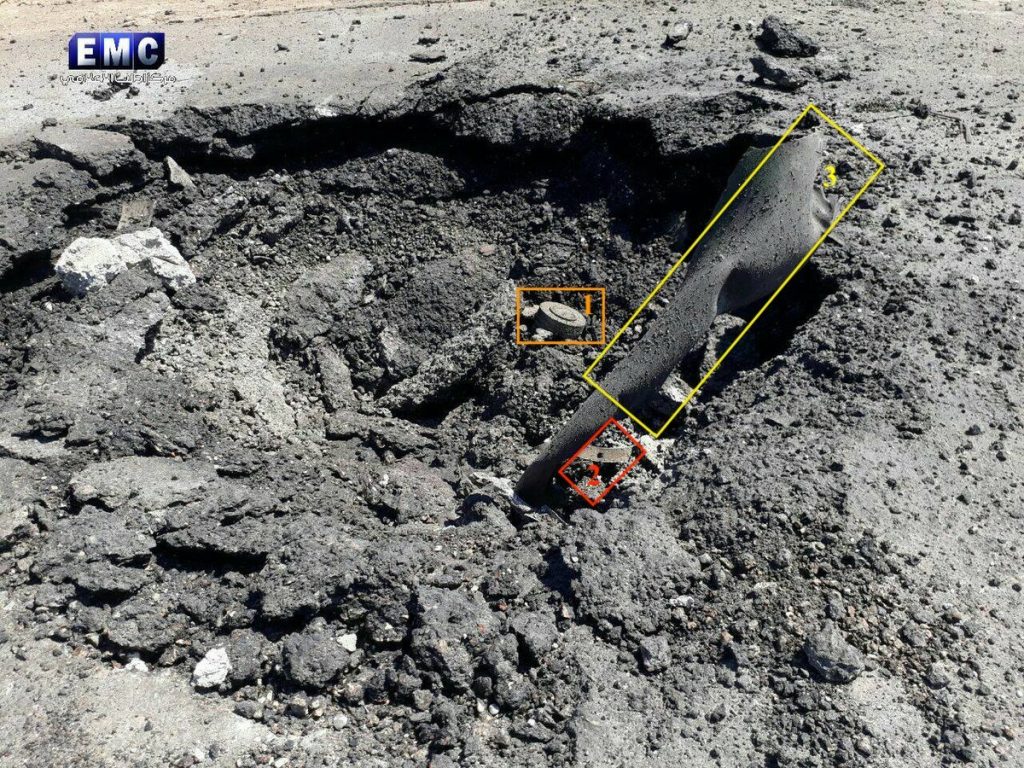
He believes these caps are a match for filler caps depicted in a schematic of Syrian chemical bombs that was shown during a Russian MoD press conference.

You may ask how he was able to determine the caps were the same from a drawing? The OPCW-JIM claimed the cap found at Khan Sheikhoun was the same as that of “a” Syrian bomb without saying which one. Higgins devised the M4000 theory from that.
The OPCW-JIM said of the filler cap:
According to information obtained by the Mechanism, the filler cap, with two closure plugs, is uniquely consistent with Syrian chemical aerial bombs. The Mechanism was provided with an assessment of the filler cap and with chemical analysis showing sarin and a reaction product of sarin with hexamine that can only be formed under very high heat. Information was also received that additional metal fragments collected from the crater may possibly correspond to parts of Syrian aerial chemical munitions.
Emphasis mine
In a previous report, I showed how that claim was false as the Russian made HE fragmentation OFAB bombs also use a filler cap with “two closure plugs”:
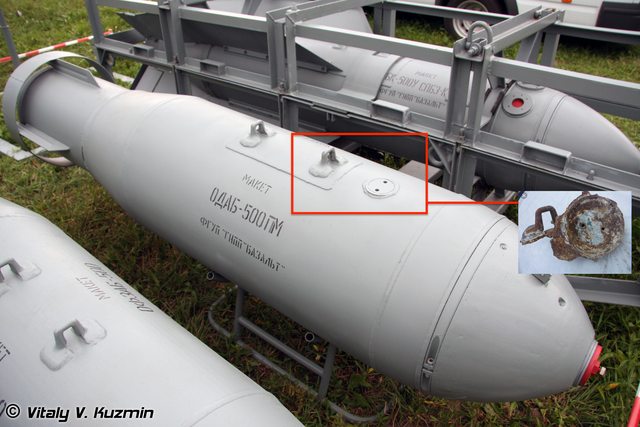
The OPCW-JIM goes on to say:
The munition remnants recovered from the crater by unidentified individuals are assessed to be associated with an air-delivered chemical bomb. Specific munition remnants, particularly the tailfin, could not be recovered. The absence of a chain of custody relating to the munition remnants diminishes their probative value.
Emphasis mine
In the case of Al-Lataminah, there was more physical evidence in terms of munition remnants than at Khan Sheikhoun and in the run-up to his debate with Professor Theodore Postol of MIT, Eliot commissioned Forensic Architecture to create a 3D model of the M4000 and to then attempt to match some of the remnants found at Lataminah with this model. Oddly, Eliot did not ask FA to attempt to model the filler cap.
The Munition Remnants

Here is a schematic put together for Eliot Higgins depicting the various pieces of debris allegedly collected at Al-Lataminah. In the centre is the technical drawing of the M4000. I have added numbering to each piece to make it easier to reference. To the right of each remnant, I have added the date it was allegedly received by the OPCW-FFM. These dates are the 17/7/17 and 18/7/17. The date of the alleged event was 30/3/17. Each piece was covered in sarin some 15 weeks after the event is said to have taken place. There is no chain of custody for the pieces.
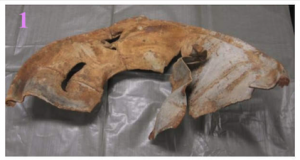 | Received by the OPCW-FFM on 17/7/17 |
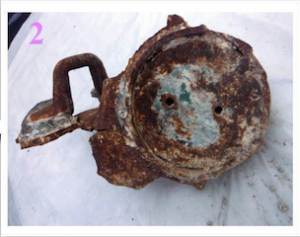 | Received by the OPCW-FFM on 18/7/17 |
 | Received by the OPCW-FFM on 18/7/17 |
 | Received by the OPCW-FFM on 17/7/17 |
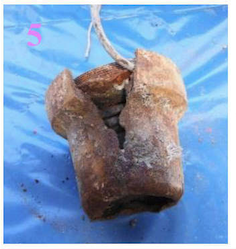 | Received by the OPCW-FFM on 17/7/17 |
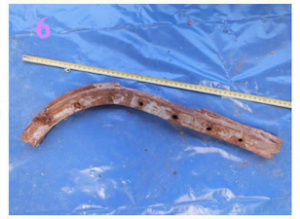 | Received by the OPCW-FFM on 17/7/17 |
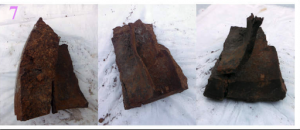 | Received by the OPCW-FFM on 18/7/17 |
Interestingly piece “2” (filler cap with lug) was not recorded as having been found in Lataminah at the impact site or anywhere else for that matter. It first appeared on 18/7/17 when it was handed to the FFM by the White Helmets covered in sarin. There is no other mention of this piece in any of the source materials I have looked at concerning the event.
Forensic Architecture – The Rail
In
We were initially asked to build this model by Eliot Higgins, in advance of (and for presentation at) a panel discussion here at Goldsmiths, University of London, hosted by the Centre for Investigative Journalism. We modelled the fragments requested.
Forensic Architecture in an email to me on the 21/8/19
Here is the FA investigation:
https://forensic-architecture.org/investigation/chemical-attacks-in-al-lataminah
You will note they leave pieces 2, 4 & 6 from their modelling.
- 2 = Filler cap with lug
- 4 = Fuse
- 6 = Metal rail
Given how much of a big deal Eliot made of this particular filler cap with seemingly attached lug I was surprised to note that FA left this out from their modelling so I asked them about this along with the other pieces mentioned above:
I can only say once again that the initial commission did not entail our modelling those fragments.
Forensic Architecture, email response to me on 28/8/19
So Eliot didn’t request the pieces numbered 2, 4 & 6 to be modelled. Why?
Let’s start by looking at piece number “6”. This is referred to as a “metal rail” by the FFM. According to Eliot Higgins, this piece from the Lataminah site matches a piece from the Khan Sheikhoun crater.
So we have these metal straps that were inside the Khan Sheikhoun crater that were also in the March 30th crater..
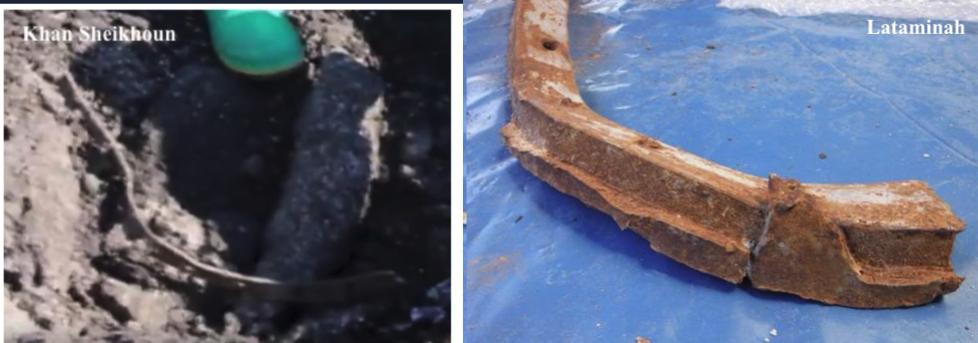
Here are the two pieces from their respective sites. Left is the Khan Sheikhoun piece and right is the Lataminah piece (discussed herein). They are very clearly two different pieces whose only similarity is that they both have holes. The left piece is much thinner and has holes that face inwards towards the bend. The left piece is much broader with holes facing away from the curvature. It shouldn’t take too much convincing for the reader to conclude these are not the same items. Yet Eliot is quite sure they are. From his own blog he provides this image trying to suggest they are the same:
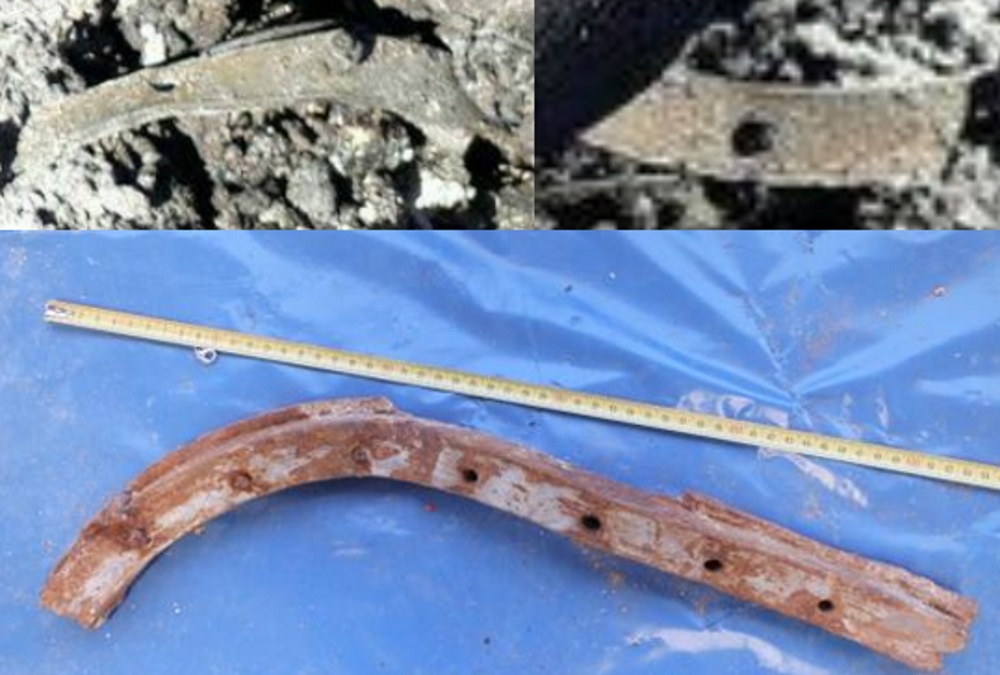
These are straps that are used to hold the bomb together.
Yet whilst being certain of what these pieces were and their usage he didn’t ask FA to model them. Here is where Eliot believes these “straps” are used on the M4000:
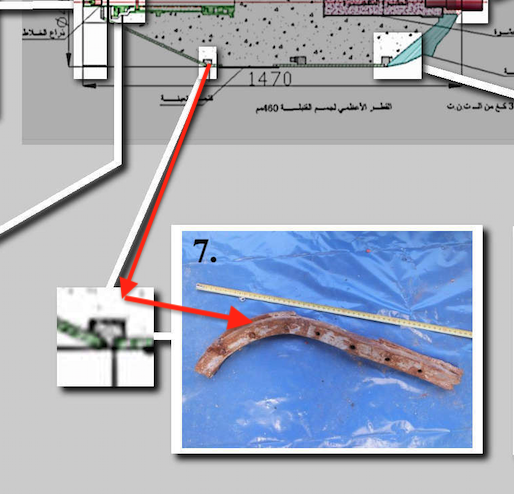
You immediately see a problem here. The metal rail is bent in an almost perfect 90° curvature yet the piece of the bomb Eliot claims it fits into requires a 45° angle. He was asked about this in the comments section of his blog to which he responded:

So his explanation on how a 45° angled piece of metal became a 90° curvature was because it had been “involved in an explosion and impact..”
I don’t think I need to say any
During my communications with FA, something bizarre occurred. They informed me Eliot hadn’t requested the “rail” be modelled as part of the original commission but pointing to a previous Twitter exchange I had with Higgins on the matter FA took it upon themselves to model the rail into their 3D model for my benefit, saying:
We hope that our analysis of this fragment provides a possible resolution to questions that you have previously
posed in relation to Eliot’s original analysis.
Why were they seemingly jumping to Eliot’s defence? They had to manually search for that exchange, without prompting from me, then take the time to model the piece I was questioning Higgins on. Here is that Twitter exchange from October 2018:
Given that Eliot claimed it was a “cross-section” that “[held] the bomb together” and pointed to the 45° angle from payload body to nose-cone, FA decided he was wrong and they believed they had figured out where the “rail” belonged. Following are the slides they sent me.
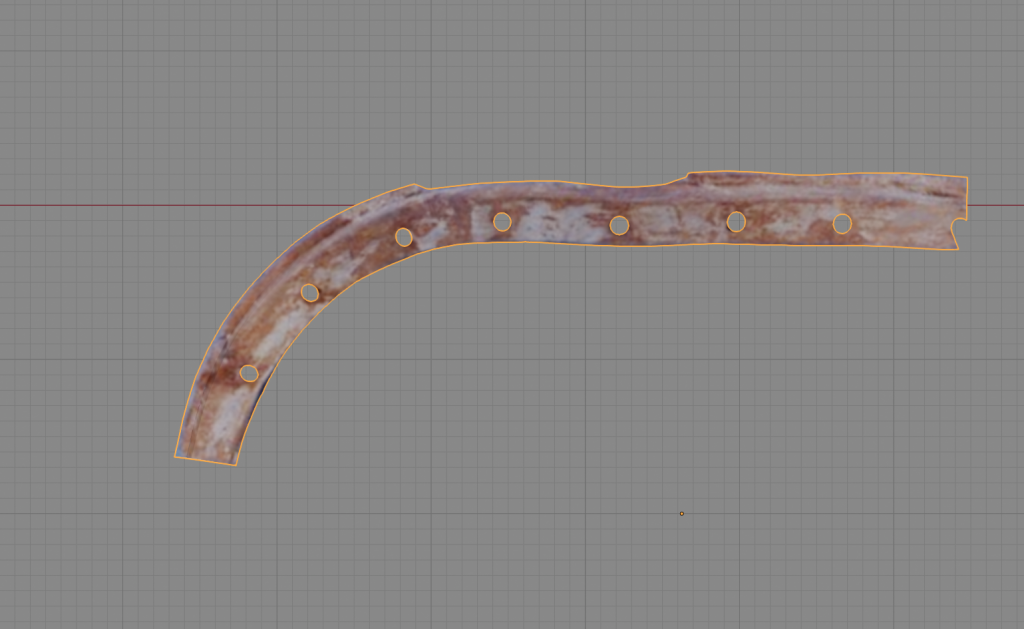
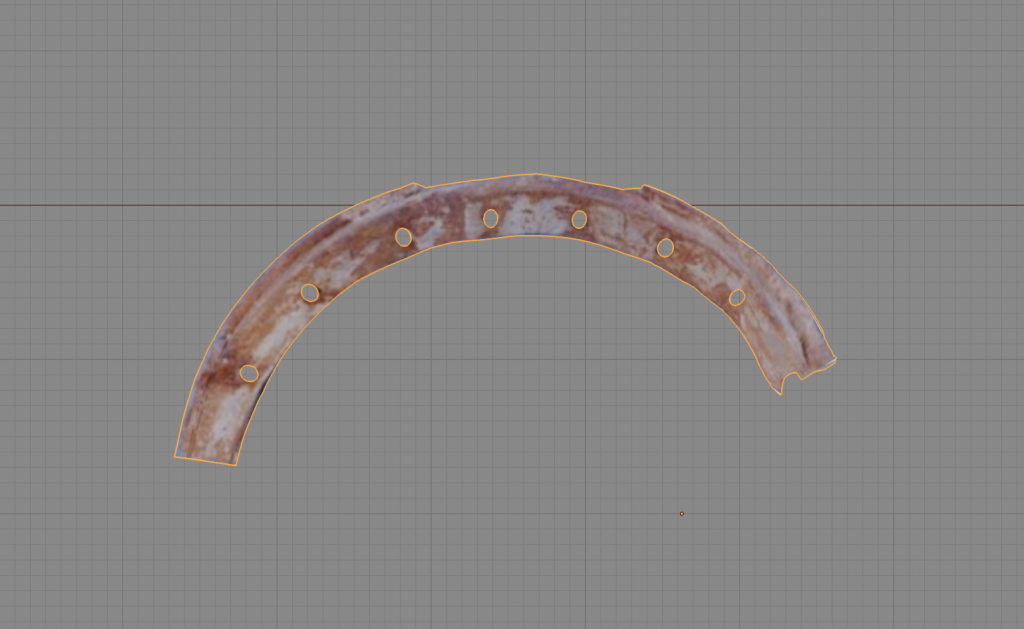
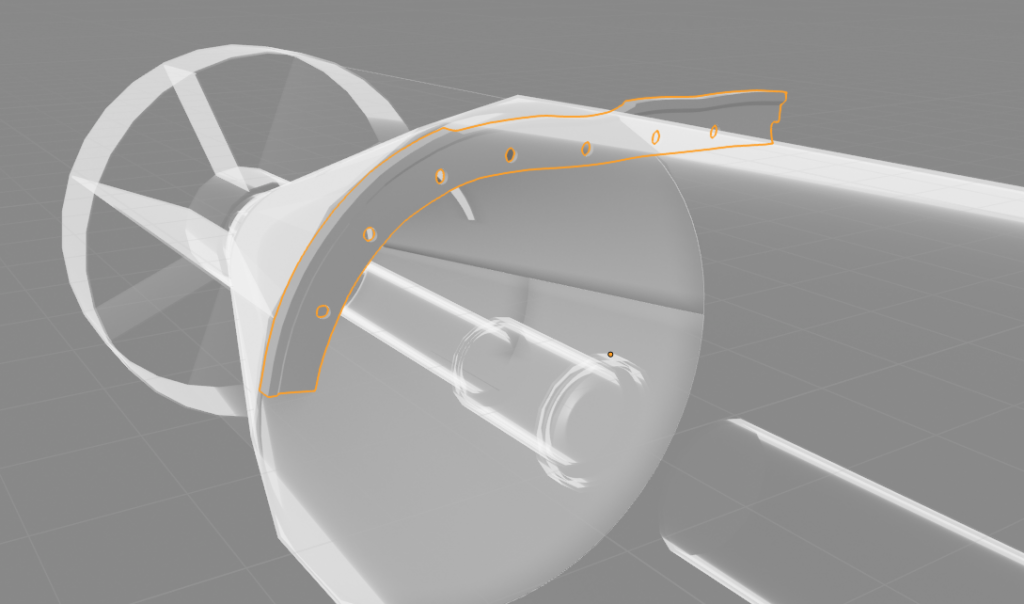
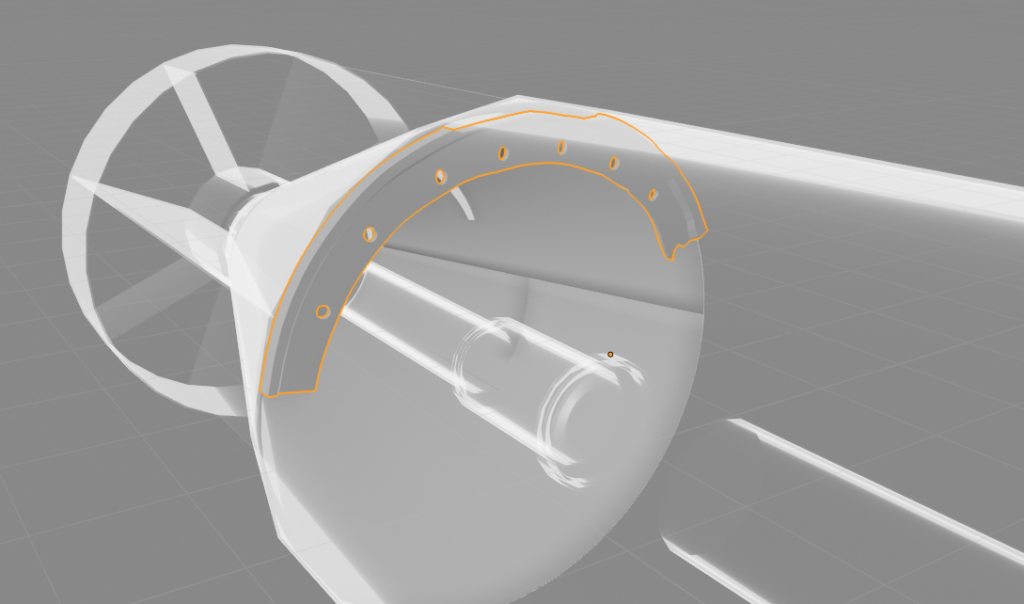
So not this:

I was intrigued at why FA believed this remnant was originally
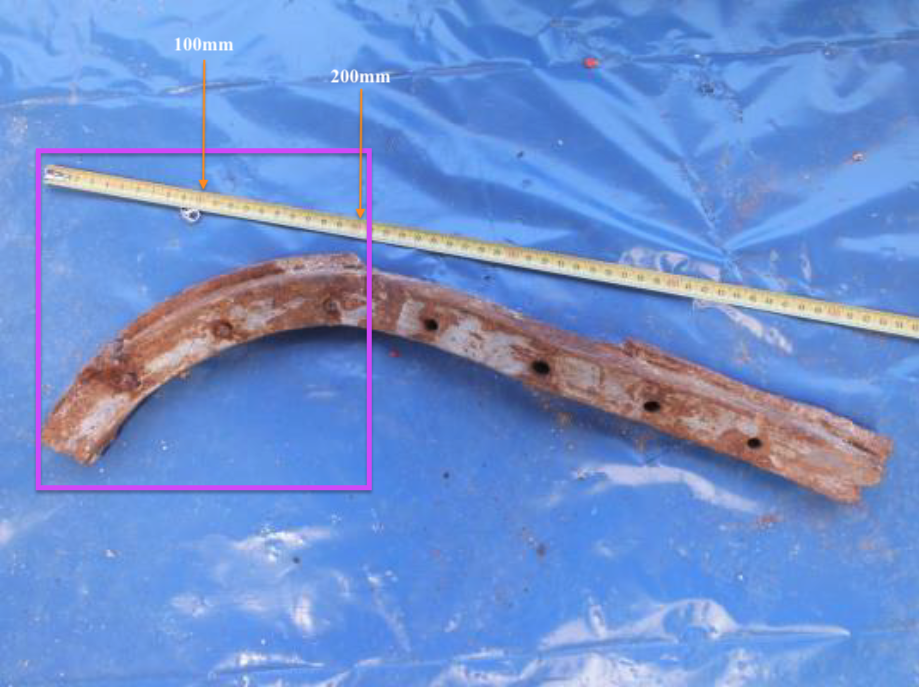
I went back and took a look at the other images of the rail provided by the FFM to make sure I wasn’t missing something.

Here is the rail from above. Had this piece originally been circular then you would expect to see signs of stress on the metal as it was forcibly reshaped. That isn’t the case. What we instead see is a pretty decent perfect 90° curvature that extends over 200mm from left to right.
But there was yet another issue I had with accepting FA’s suggestion this rail held parts of the bomb together. The bolt holes would be on the inside of the bomb between the conical tail section and the payload body. How would one gain access to be able to secure the bolts?

What this suggests is that FA made the rail fit the designation. I asked about this:
2. Regarding the brace; so as to rule out any concerns that may arise, in this instance, that this wasn’t a case of simply ‘looking for somewhere to put it’ (excuse my bluntness) then making it fit, could I ask you, in a brief response, to point me to where on the horizontal section you believe exists evidence the metal piece was once a semicircle and also note, if you would, why you didn’t reach that conclusion whilst you doing the original modeling at Bellingcat’s request?
FA replied:
There are a handful of aspects of the physical condition of ‘3’ that suggest some deformity has occurred. The digital assets upon which we made this conclusion are in their totality at your disposal.
Note that “3” in mycorrespondance with FA refers to the rail which is “7” for the purpose of this report
They offered no other explanation as to how they ascertained the rail was a perfect curvature in its former life. Indeed the FFM report stipulates the piece has a “square-shaped cross-section” as the reader will see for themselves that it does.
Forensic Architecture – The Tail Fin
As we know from the M4000 schematic, the diameter of the tail fin is 460mm. FA claimed to have been able to deduce a measurement from the images of the tail fin in the FFM report.
After watching this presentation I was reminded of how the OPCW-FFM, who had the tail fin section in their hands,
The FFM took numerous measurements of this item. Given the level of deformation, these measurements are only approximate dimensions. These approximate dimensions have not been included.

I was therefore intrigued at how FA drew their conclusions from images that the FFM couldn’t draw whilst holding the piece in their hands, so I asked them:
Secondly, if I may, regarding your measurements of the tail fin section. You say that your modelling determined a diameter of 0.460m as per the Russian M4000 slide. However, I note from the FFM report that due to the deformation of the metal piece they were only able to take “approximate dimensions” and therefore could not include those measurements in their report. An educated guess as to why they don’t include estimates would presumably be due to the importance of specific measurements giving a correct outcome. A
My question in a 21 August 2019 email to FAmillimeter or two out from a correct measurement would give an incorrect result and thus predict an incorrect tail fin diameter.
Given the FFM’s reluctance to share estimated values, may I ask what data you used in Blender to calculate the diameter of the piece and are you 100% confident in your calculations in this case?
They responded:
Our calculations were based on measurements provided by elements of certain images pertaining to the object, including but not limited to the measuring tape visible in the image of the deformed tail fin.
We have an extremely high level of confidence in our measurements, and in the specific conclusions presented in ‘Chemical Attacks in al-Latiminah’.
My question wasn’t answered. How exactly did FA measure something from images that experts, with the very best of technology available to them, couldn’t do even with the piece in front of them? In a follow-up email on the 28/8/19 I pressed a little harder on the issue of the tail-fin measurements:
Given how uncertain the OPCW was of the measurements of the tail fin, bearing in mind they had it their hands, you will forgive my questioning of your measurements on the piece. The difficulty I have is understanding how you were able to reliably determine the diameter of a scrunched tail fin section using photographs yet experts with access to the very best equipment available couldn’t. I’m sure you will understand my concerns in that regard.
I continued:
That said; The last question on this matter is, and I will pay you for your time, could you share with me a short presentation on how you gathered the measurements from the tail fin exactly? Armed with these measurements and data, would you then have any objection to me having them peer-reviewed?
Please send me costs and timescales of completion by return.
Here I offered to pay FA to show me how they reached their conclusions. In the email dated 28/8/19 they replied:
To your first point, I’m afraid it is not our practice to take commissions from private individuals in this way, nor do I, in any case, make decisions on which commissions FA accepts. I can only say that the techniques of architectural analysis we deployed in this case have previously been considered permissible and indeed decisive by national and international courtrooms, supranational bodies, and commissions and inquiry processes around the world. We welcome academic review, and have open sourced our models at your request, presumably to this end.
So they wouldn’t share with me their workings yet proclaim to “welcome academic review..”;
We welcome academic review, and have open sourced our models at your request, presumably to this end.
They did indeed provide their models but in the absence of the data used to design those models, they are nothing more than 3D artefacts collated into a short presentation. Open-sourcing means just that – opening up your sources for critical analysis and verification. Given FA refuses to explain how they reached the measurement of 460mm for the tail fin diameter I must work off the premise they guessed that measurement.
This idea of claiming to be “committed to the principles of open-source research and investigations” and then not providing information on how you reached a critical measurement is not acceptable. If your work is open-sourced then open up your sources.
Recap
So far I have looked at the “rail” shaped piece of metal that Eliot Higgins claims were to be found at Khan Sheikhoun and Al-Lataminah. I have shown how both pieces of metal are quite different and are not the same shape.
I looked at the Forensic Architecture modelling of the same rail and showed the many problems that exist with their theory the piece was used to hold two sections of the M4000 together.
I also looked at their modelling of the tail fin section and showed how, in the absence of providing their source data and modelling methodology, there is no way of telling if their conclusion is correct. I also noted how the OPCW-FFM who had the remnant in their hands couldn’t deduce a measurement from this piece they would have been able to stand over.
The Fuse
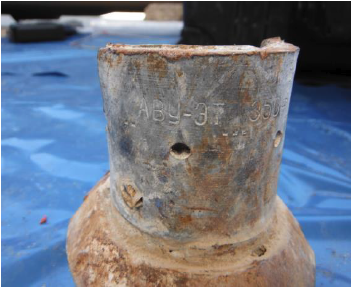
This is a Russian AVU-ET fuse that is used in the large majority of Russian aerial bombs. It is unlikely that this fuse would be used in a Syrian chemical bomb. Countries sell bombs to other countries and not necessarily bomb parts. As one expert I spoke to said, “It’s not eBay.ru. You can’t just order a box of fuses for bombs”. Which makes sense when you think about it. This is also a likely reason why Eliot didn’t ask FA to include it in their M4000 model.
But it should be noted that all the remnants presented must come from the same munition as claimed and in this instance, that claim is from an M4000. At Khan Sheikhoun, you will recall, Eliot dismissed the remnant evidence he couldn’t account for which in itself invalidated any theory he posited. He seems to be attempting the same thing at Lataminah. If it can’t be accounted for, leave it and move on.
The Filler Cap
This was also left out from the FI model as Eliot hadn’t requested the piece to be modelled. It’s an interesting item to investigate.
The OPCW-JIM concluded that the filler cap at Khan Sheikhoun was “uniquely consistent with a Syrian chemical bomb”.
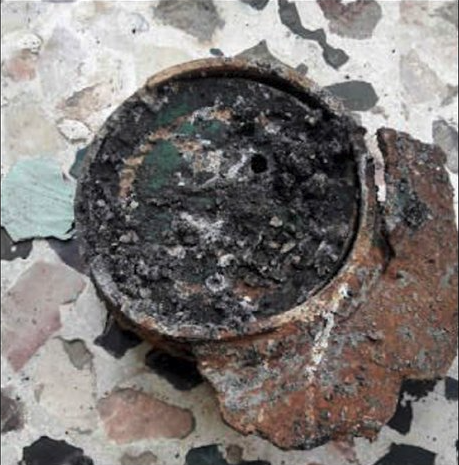
Oddly, this filler cap never reached the OPCW-FFM or JIM but was instead in the possession of “Human Rights Watch” who relayed the information to the JIM. Based upon that information the JIM concluded it was from a Syrian chemical bomb.
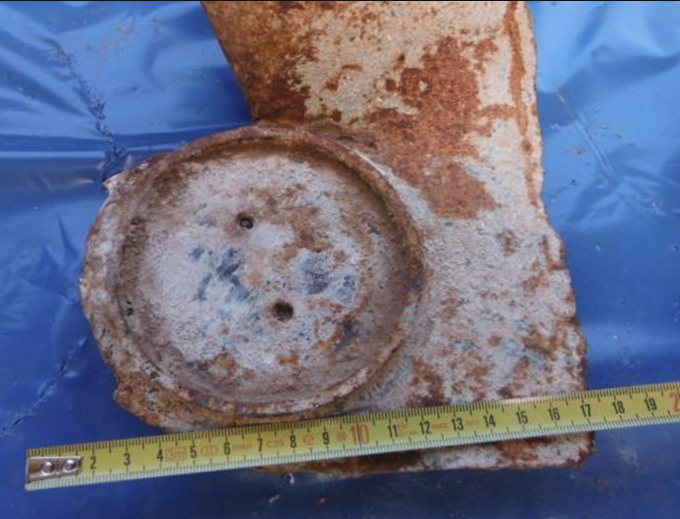
This Lataminah filler cap was handed to the OPCW-FFM on the 17 July 2017, 15 weeks after the alleged event took place and yet tested positive for sarin. But as discussed in my previous report, from out of nowhere on the 18 July 2017 a new piece of evidence was submitted to the FFM.
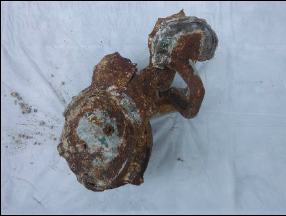
This cap was laden with sarin and its degradation products. There is no chain of command for the piece, no reference to where it was found, no geolocation offered to or by the FFM and no video of the piece being recovered.
I also noticed a few oddities with the cap which I discuss in this presentation:
There is a second part of this presentation that is already recorded and will be posted as supplementary addition in due course. I didn’t want to bombard the reader with too much information at this stage.
Conclusion
So what conclusions can be drawn from this latest report?
The narrative of filler caps is one that deserves great scrutiny because it is the one the OPCW-JIM hangs its coat on in blaming the Syrian government for the sarin attack in Khan Sheikhoun. Even though the OPCW-FFM nor JIM ever received the filler cap, and noted it was handed over by “by unidentified individuals” to Human Rights Watch then went on to note, “The absence of a chain of custody relating to the munition remnants diminishes their probative value.” – none of that seems to have given them cause for concern. Who were these individuals? What was the chain of custody? Why was the cap not handed over to the OPCW? Why didn’t Eliot Higgins ask FA to model the filler caps as part of their investigation? What about the filler cap with lug, examined in this report? Where did it come from? Where was it found? What is its provenance? What is its chain of custody?
The Forensic Architecture interjection to an old exchange I had with Eliot Higgins referencing “the metal rail” raises questions in itself. Why did they feel the need to come to Eliot’s defence whilst inadvertently disagreeing with what it was he was arguing? Their suggestion the metal rail connected the payload body to the conical tail section of the M4000 is without merit. I have shown how it would be impossible for the bolts to have been accessed and pointed to the lack of evidence on the piece that it ever was circular.
What about the FA tail section measurement? Well in the absence of transparency on how they measured this piece we are asked to trust their methods, which I can’t. I trust verifiable data – not words. How did FA conclude the tail section was that of an M4000? Have they seen an M4000 before? How did they deduce the tail section had 8 fins? How did the reach a specific result of 460mm from images? Will they show their workings?
What the available evidence suggests is that Eliot Higgins was acutely aware of the lack of evidence supporting his M4000 theory at Khan Sheikhoun hence why he consistently pivots to Lataminah when discussing the event. He then cheery picked pieces of the alleged bomb debris to ask FA to model for him ahead of his debate with Ted Postol. In doing so FA made the evidence fit the dimensions of the M4000. Eliot used this model to wow the audience and distract Ted Postol at the debate. Yet Eliot’s video presentation brought to my attention all that was wrong with his claims in this matter. From the video, I uncovered the White Helmets had staged chemical sampling in Lataminah – this lead to a widely circulated report I released. I uncovered that Eliot’s claim the metal rail was the same at Khan Sheikhoun and Lataminah was false and that Eliot hasn’t a single technical argument of his own. He gives definition to the phrase “argumentum ad verecundiam” otherwise known as, Appeals to Authority. Eliot acts like a clearinghouse for the claims made by authoritative bodies.
I believe this report lends further doubt to the official narratives of both events at Khan Sheikhoun and Al-Lataminah. I don’t see any convincing evidence of an M4000 having been used at either location and I can only, therefore, conclude the M4000 theory, given life by Eliot Higgins, is without foundation and supporting evidence and should now be discounted from the discourse of the aforementioned discussions.
The modelling from Forensic Architecture doesn’t hold up to scrutiny and therefore leads the author of this report to draw deep scepticism from their investigation. I will, however, adjust the record accordingly should they present how they measured the tail fin section and how they concluded the tail fin from the M4000 has 8 fins.
I feel this isn’t the end of my investigations into Khan Sheikhoun and Al-Lataminah as I constantly uncover new and interesting facts that I intend to write about. Given the many thousands of readers that read each report I produce I sense there’s a desire for these types of investigations to continue, so they will do so.
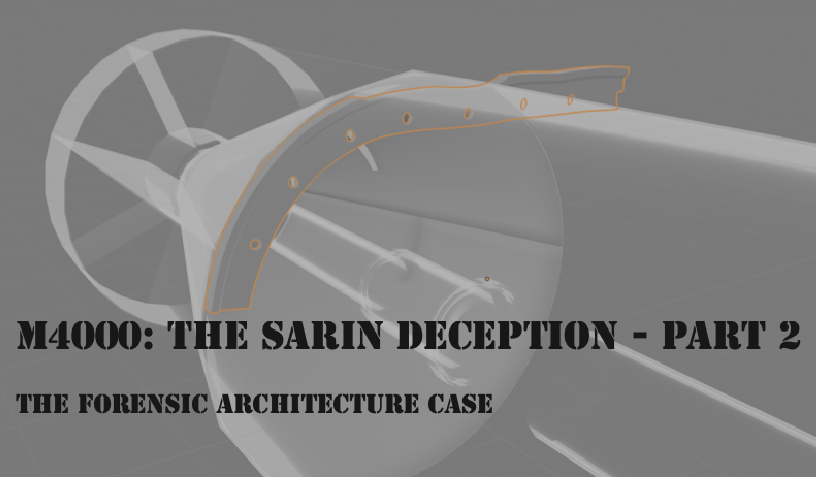
Forensic Architecture’s model of the hole above the bedroom in Douma on the left, from video in reality on the right:
https://imgur.com/qIQNgNP
Great work!
Thanks Jules.
Thanks for taking the trouble to post.
The comments in the nov 2017 Bellingcat article you link to
https://www.bellingcat.com/news/mena/2017/11/13/russia-accidentally-provide-best-evidence-syrian-governments-involvement-sarin-attacks/comment-page-1/#comments
are also interesting.
Do FFM specify how measured “inter-hole” 07SD distance.
Dont know what is accepted endpoints and margins would be more accurate but if centre to centre 35mm may fit.
Also holes also seem off-centred relative to circumferential margin just eye-balling 07SD in FFM report
Thanks for your comment. I will get back to you on this. Bit snowed under at the minute.